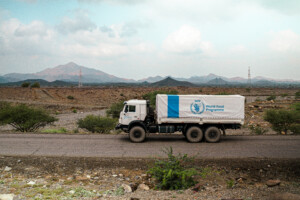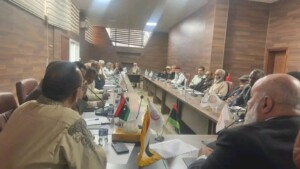Sudan OCHA bulletin 34: Food aid for displaced in Guldo, Central Darfur
The Office for the Coordination of Humanitarian Affairs (OCHA) in Sudan reported in its bulletin this week that the World Food Programme (WFP) distributed 90 metric tons of food aid to some 9,500 displaced people in Central Darfur’s Guldo town last Thursday.
As of 19 August, the number of South Sudanese refugees who have taken refuge in Sudan since mid-December 2013 has reached 191,624, according to the UNHCR.
Thousands of newly displaced arrived in Guldo in Jebel Marra, Central Darfur, between March and June following fighting between government forces and the Sudan Liberation Movement, led by Abdelwahid El Nur, in the area.
The Office for the Coordination of Humanitarian Affairs (OCHA) in Sudan reported in its bulletin this week that the World Food Programme (WFP) distributed 90 metric tons of food aid to some 9,500 displaced people in Central Darfur’s Guldo town last Thursday.
As of 19 August, the number of South Sudanese refugees who have taken refuge in Sudan since mid-December 2013 has reached 191,624, according to the UNHCR.
Some 22,000 displaced by tribal fighting in North Darfur's Mellit locality need assistance.
School buildings in nine camps for the displaced in South Darfur are in urgent need of rehabilitation and expansion.
The West Darfur government has established a crop protection committee to prevent land disputes between displaced farmers and herders in El Geneina locality.
Thousands of newly displaced arrived in Guldo in Jebel Marra, Central Darfur, between March and June following fighting between government forces and the Sudan Liberation Movement, led by Abdelwahid El Nur, in the area.
In June, an inter-agency assessment mission visited the area of Guldo and identified the needs of the newly displaced people. Emergency food aid however only arrived after a delay of nearly two months. This was as a result of difficulties faced by the WFP in obtaining permission to transport the stocks from the Central Darfur capital of Zalingei to Guldo.
All 13,500 displaced people who have taken refuge in Guldo this year and who are eligible for food aid have now received emergency food rations, according to the WFP. Continuity of food assistance to displaced people in Guldo town will be determined by further assessment and registration by the International Organization for Migration (IOM) or in the event of a deterioration of the humanitarian situation in the town.
The UN Children’s Agency (Unicef) and partners are working with the government’s Department of Water and Sanitation (WES) to drill an additional boreholes and construct 500 latrines.
More than 191,000 South Sudanese refugees in Sudan
This week, most of the newcomers arrived at White Nile state (1,533) and South Kordofan (371) bringing the number of new arrivals in August so far to 2,636. This is significantly less than the influxes in June and July, because of rains blocking the roads.
The UN Refugee Agency (UNHCR) and its partners are striving to ensure that all newly arriving households receive emergency shelter and household supplies in a timely manner. However, distributions are hampered by the sheer number of refugees in addition to heavy rains that prevent timely access to some affected areas.
During the past two weeks 7,995 children were screened for malnutrition, of whom 122 (1.5 percent) were identified with severe acute malnutrition and 553 (6.9 percent) with moderate acute malnutrition. All children were provided with the required treatment.
As cholera cases continue to be reported in South Sudan, contingency planning and preparedness plans have been put in place in Sudan, with a focus on areas bordering South Sudan. The World Health Organization (WHO) recently conducted a risk assessment for cholera in White Nile state, and discussed the possibility of conducting a cholera vaccination campaign for new arrivals using Oral Cholera Vaccine (OCV).
22,000 people displaced in Mellit need assistance
From 13 to 19 August, the IOM completed the verification of displaced Berti and Zayadiya taking refuge in North Darfur’s Mellit. They fled their homes in the locality following fighting between the two tribes in April. 2,083 Berti families (about 10,000 people) and 1,605 Zayadiya families (about 9,000 people) took refuge in the area of Mellit. An additional 590 displaced families (about 3,000 people) from El Ades and Hillet Ahmed villages have also taken refuge in Mellit town.
So far, aid organisations are providing water, health and nutrition assistance. The total displaced population in Mellit town (22,000 people) is set to receive food assistance.
Land disputes among displaced, nomads in West Darfur
As in former years during the planting season, many displaced people living in El Geneina locality started searching for land to cultivate in order to supplement their household food stocks. This practice often leads to land disputes between displaced farmers and nomadic Arab tribes who also farm these areas.
Several disputes over access to land and destruction of farmland by livestock have already been reported this year in villages throughout El Geneina locality. In response, the government has recently established a crop protection committee to foster peaceful coexistence between the two sets of communities. The committee is co-chaired by the state’s Ministers of Finance and Agriculture.
Displaced school children in South Darfur need aid
Unicef and the South Darfur Ministry of Education have completed an assessment of nine schools at the camps for the displaced in South Darfur’s Nyala and Bielel localities between June and the first week of August 2015.
According to the mission findings, 506 classrooms need rehabilitation. The schools further lack teacher and student kits, and textbooks.
There are 87 schools and 873 classrooms in the nine camps, providing education to 97,163 school children. This amounts to an average class size of 93 students per classroom, which is over double the minimum standard of 40 students per classroom set by the Inter-agency Network for Education in Emergencies.
564 latrines are available at the schools. According to Sphere Minimum Standards, however, the 87 schools require 1,700 latrines.
Read the full bulletin here











 and then
and then